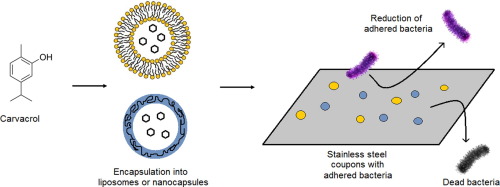Food Research International ( IF 7.0 ) Pub Date : 2020-03-03 , DOI: 10.1016/j.foodres.2020.109143 Fabíola Ayres Cacciatore 1 , Michelle Dalmás 1 , Caroline Maders 1 , Henrique Ataíde Isaía 2 , Adriano Brandelli 2 , Patrícia da Silva Malheiros 1

|
Carvacrol is a natural antimicrobial capable of inhibiting several microorganisms. The encapsulation of this compound may increase its stability, water solubility and provide controlled release. In this study, carvacrol encapsulated into nanoliposomes (NLC) and polymeric Eudragit® nanocapsules (NCC) was tested against Staphylococcus aureus, Listeria monocytogenes, Escherichia coli and Salmonella spp. adhered to stainless steel. NLC showed an average diameter of 270.8 nm, zeta potential of +8.64 mV, and encapsulation efficiency of 98%. Minimum Bactericidal Concentration (MBC) of NLC was 3.53 mg/mL against Salmonella and 5.30 mg/mL against the other bacteria. NCC presented an average diameter of 159.3 nm, zeta potential of +44.84 mV, and encapsulation efficiency of 97%. MBC of NCC was 4.42 mg/mL against E. coli and 3.31 mg/mL against the other bacteria. After 2 h incubation with NCC at carvacrol concentration equivalent to ½ MBC, viable counts of Salmonella and E. coli were below the detection limit (1.69 CFU/mL). The population of L. monocytogenes and S. aureus was reduced by 2 log CFU/mL in 6 h. Afterwards, pools of each bacterium were separately adhered to stainless steel coupons (initial population 6.5 CFU/cm2). Salmonella and E. coli were inhibited below the detection limit using the NCC at concentration equivalent to MBC, while L. monocytogenes and S. aureus were reduced by 4 log CFU/cm2 and 3.5 log CFU/cm2, respectively. Although free carvacrol presented better results than encapsulated one in all tests performed, using encapsulated carvacrol could be more interesting for food applications by masking the strong aroma of the compound, in addition to a controlled release of carvacrol. The results suggest that NCC have potential for use in food contact surfaces in order to avoid bacterial adhesion and subsequent biofilm formation.
中文翻译:

香芹酚封装到纳米结构中:对粘附在不锈钢上的食源性病原体的表征和抗菌活性。
香芹酚是一种能够抑制多种微生物的天然抗菌剂。该化合物的包封可以增加其稳定性,水溶性并提供控制释放。在这项研究中,对封装在纳米脂质体(NLC)和聚合Eudragit®纳米胶囊(NCC)中的香芹酚进行了抗金黄色葡萄球菌,单核细胞增生性李斯特菌,大肠杆菌和沙门氏菌的测试。附着在不锈钢上。NLC显示平均直径为270.8 nm,ζ电势为+8.64 mV,封装效率为98%。NLC对沙门氏菌的最低杀菌浓度(MBC)为3.53 mg / mL对其他细菌为5.30 mg / mL。NCC的平均直径为159.3 nm,ζ电位为+44.84 mV,封装效率为97%。NCC的MBC对大肠杆菌为4.42 mg / mL,对其他细菌为3.31 mg / mL。与相当于1/2 MBC的香芹酚浓度的NCC一起温育2小时后,沙门氏菌和大肠杆菌的活菌计数低于检测极限(1.69 CFU / mL)。单核细胞增生李斯特菌和金黄色葡萄球菌的种群在6小时内减少了2 log CFU / mL。之后,将每种细菌的池分别粘附到不锈钢试样片上(初始种群为6.5 CFU / cm 2)。沙门氏菌和大肠杆菌使用浓度等于MBC的NCC可以将其抑制到检测限以下,而将单核细胞增生李斯特菌和金黄色葡萄球菌分别降低4 log CFU / cm 2和3.5 log CFU / cm 2。尽管在所有执行的测试中,游离香芹酚的结果均优于封装香芹酚的结果,但除控制香芹酚的释放外,通过掩蔽化合物的强烈香气,使用封装香芹酚可能更适合食品应用。结果表明,NCC有潜力用于食品接触表面,以避免细菌粘附和随后的生物膜形成。











































 京公网安备 11010802027423号
京公网安备 11010802027423号